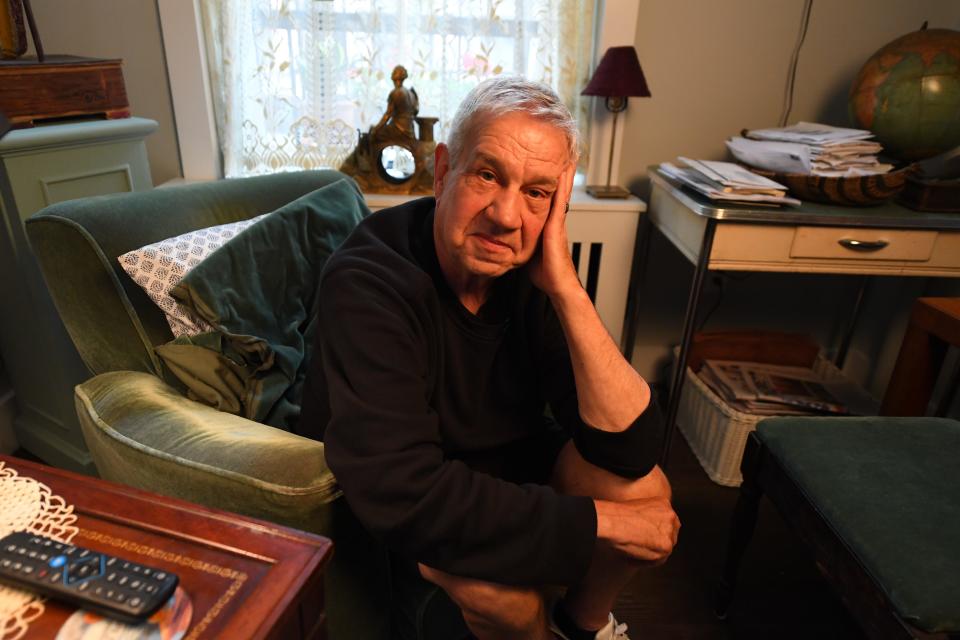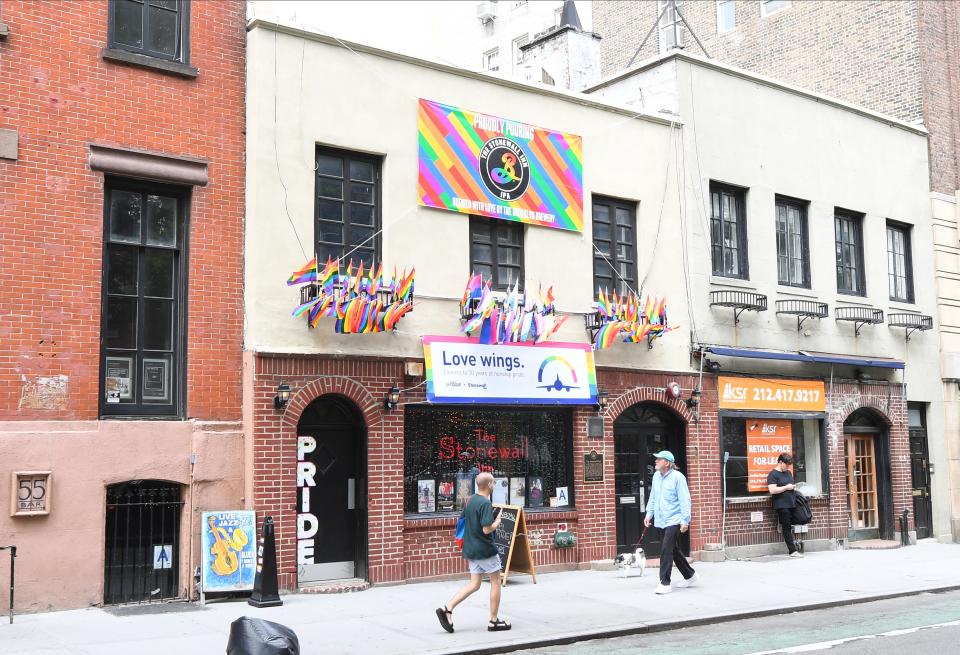Stonewall Forever: 50 years after the raid that sparked the LGBTQ movement, it goes digital
On a sweaty summer night in 1969, Martin Boyce drank up the energy along Christopher Street in New York’s West Village near a bar that pulsed with secrets of the lives inside.
The Stonewall Inn was a sanctuary where “everyone had their place,” from lesbians to homeless gay youths to drag queens who liked to vogue. They were people living on the edges in a city where “it was a sport to beat gays,” Boyce recalls.
But behind those thick stone walls brimmed the seeds of rebellion.
Boyce, 21, whose cabbie father stashed bail money in a cookie jar in case his gay son was swept up in a raid, soon found himself in a staredown with a cop amid an unwavering crowd – and near the flame that ignited a revolution for LGBTQ equality.

Tuesday, an interactive monument called Stonewall Forever will come to life, a project that aims to tell stories such as Boyce’s of how a police raid on the Stonewall Inn led to five nights of riots that ushered in five decades of Pride.
In 2019, amid challenges to LGBTQ rights, Stonewall's legacy couldn't be more relevant, activists say.
Digital extension of a national monument
Stonewall Forever debuts during the 50-year commemoration of the uprising and as New York hosts WorldPride during Pride 2019, a monthlong celebration and focus on LGBTQ rights through parades, rallies and other activities.
In 2016, President Barack Obama designated 7.7 acres along Christopher Street in Greenwich Village the Stonewall National Monument, the first national monument dedicated to LGBTQ rights. Stonewall Forever will be its digital extension.
“Stonewall is such a big moment in our history,” says Glennda Testone, executive director of New York’s LGBT Community Center, which is launching Stonewall Forever with support from Google. “It is what created the modern day civil rights movement; it’s a symbol for LGBTQ equality around the globe.”
More: Nearly 4 million LGBTQ people live in rural America, and 'everything is not bias and awful'
The Stonewall Forever interactive monument, accessible worldwide on desktop, mobile and an augmented reality app, will have archived material such as photos, letters, oral histories and a documentary featuring activists past and present. Visitors can contribute content or upload their own Stonewall memories or experiences inspired by the uprising, Testone says.
![5/28/19 2:27:35 PM -- New York, NY, U.S.A --
The Stonewall Inn, and the Stonewall National Monument in a small park in front of the inn .
Martin Boyce is a Stonewall veteran and was there during the first day of the riots in June 1969.
Martin Boyce was 21 when the riots erupted. He was outside the bar and at the flash point. He was a student in Hunter College at the time. He later ran a restaurant in the East Village. He’s 71 now and probably one of the few remaining survivors of the Stonewall Riots. He’s now an LGBTQ activist. He will be featured in a documentary that will be part of the Stonewall Forever monument.
-- Photo by Robert Deutsch, USA TODAY staff ORG XMIT: RD 138048 Martin Boyce 5/29/2019 [Via MerlinFTP Drop]](https://s.yimg.com/ny/api/res/1.2/x8TJXvzwWU9tKpXNluxH3Q--/YXBwaWQ9aGlnaGxhbmRlcjt3PTk2MDtoPTY0MA--/https://media.zenfs.com/en-US/homerun/usa_today_news_641/904e2e7a7cae6d67b1482da220dcc103)
Google.org, the philanthropic arm of Google, donated $1.5 million to enable Stonewall Forever’s creation. “The idea was born out of a question: How do you tell the story of Stonewall in such a way that not only illuminates what happened in history, but it speaks to activism and a movement going on right now?” says William Floyd, head of external affairs for Google. “It is a living monument of 50 years of Pride.”
Another critical component: Stonewall Forever will capture the diversity of the participants in the uprising and in the LGBTQ movement today – "the voices often left out” such as people of color battling violence, immigrants, transgender individuals and the young, Testone says. “We just want to expand the understanding of our community.”
More: LGBTQ families are on the cusp of dramatic growth, and millennials lead the way
The legacy of Stonewall, Floyd says, resonates in 2019. “As a gay black man, I would not have the life that I have if not for the events of 50 years ago. I would not be able to live as openly as I do. I would not be able to be married or experience the biggest part of my life: my son.”
'Get out of there, you fags'
Boyce came of age in the 1960s in New York, a city that “was very anti-gay,” he said. The LGBTQ community was left out of the many social and political changes swirling at the time. “We were ignored at the same time as being vilified on the streets.”
Homosexuality was labeled a crime or mental illness in many states. Police officers regularly raided establishments frequented by LGBTQ people, harassing and arresting bar owners and patrons.
The Stonewall Inn was a safe haven with a great jukebox and an amazing dance floor, a hub where you could be “with your own kind,” says Boyce, 71.

On June 28, 1969, Boyce, then a student at Hunter College, was outside Stonewall talking to his best friend when he heard a commotion, and word spread about a raid. As he moved closer to the bar, he watched as a police officer pushed a drag queen, who kicked the cop in the shoulder with a heel.
More: Banning gay panic defenses: The unfinished legacy of the Matthew Shepard case
The next thing Boyce heard was “flesh and bone against metal” – and these piercing words from the officer: “Get out of there, you fags, the show is over.”
The cop “turned around and raised a billy club, but he never finished. He looked in our eyes, and I took one step toward him – and the riot broke.”
The police officer seemed unnerved, Boyce says, and law enforcers quickly lost control of the situation as years of fury and frustration rippled through the crowd. “Authority collapsed with him … and consensus reigned. Everybody somehow thought whatever we were doing was the right thing,” he recalls.
The first night of the Stonewall uprising united a divergent gay population in the city, Boyce says, and led to four more nights of violence and the birth of activism.
More: 'Not just about a cake shop': LGBT people battle bias in everyday routines
After a few days, Boyce, like others, felt something even bigger starting to shift. Attitudes of straight people softened; groups formed to protect members of the LGBTQ community. “It was new and amazing," he says. "Within weeks, there was collective Pride.”
Boyce soon had his own epiphany moment on a city street en route to the subway. As he passed a “huge man hauling garbage,” the worker glared – “then he raised his fist in salute.” Boyce was hit with a striking realization: “There was valor displayed at Stonewall.”
Within a few months, at least two gay rights groups took root in the city. A year later on June 28, 1970, thousands flocked to the Christopher Street Liberation Day march, the city’s first Pride. A sister march was held in Los Angeles.

'Not going back in the closet'
It is not known how many Stonewall survivors are left. Boyce says he thinks the numbers are dwindling; many, like his best friend, were lost to AIDS. That makes “retrieving our history” and telling the untold stories through a living, digital monument “very, very important,” he says. And the role of women should not be in the shadows. “Lesbians were 100% behind us,” he says.
When Boyce looks at the altered landscape 50 years later, he acknowledges tremendous strides for LGBTQ equality – a landmark gay marriage ruling in 2015 – but also the setbacks – everything from bathroom bills to transgender in the military policy.
Testone sees the 50-year mark as a “moment of recommitment” for the LGBTQ community. “The last couple of years have shown us our freedom and equality are not guaranteed. I see the effort to push our rights and protections back, and I see the community rising up and saying no,” she says. "We are not going back in the closet."
More: 3 years after same-sex marriage ruling, protections for LGBT families undermined
After the riots, Boyce returned to college, trained as a chef and later ran a restaurant in the East Village. He has been a powerful voice for LGBTQ rights in the past five decades – and he is resolute that Stonewall cannot be undone.
“I have a certain optimism we are ready to handle it. If there is a fight, we are going to fight,” he says. “Human rights are involved. Once you realize a person’s happiness is at issue, there’s no turning back.”
This article originally appeared on USA TODAY: Stonewall Forever: 50 years after the raid that sparked the LGBTQ movement, it goes digital
